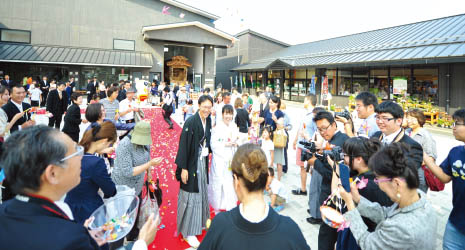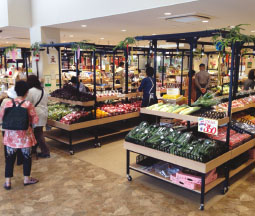Home > Highlighting JAPAN > Highlighting Japan December 2018 > The Art of Emotion: Japanese Entertainment and Hospitality
Highlighting JAPAN


Not Just Another Roadside Attraction
As of April 2018, there were 1145 michi-no-eki (roadside stations) in Japan. One of them, known as Michi-No-Eki Nikko (Nikko-Kaido Nikoniko Honjin), hosts more than one hundred events a year. Facility manager Kayoko Kato introduces the many attractions and facilities of Michi-no-Eki Nikko.
Michi-no-eki are roadside stations equipped with a parking lot and toilets that are both free of charge and open 24 hours a day, and also provide traffic reports and information about tourist sites in the surrounding area. Beyond that, the restaurants and shops on the premises promote local specialty products, and are expected to help vitalize the local community. One of these roadside stations, Michi-No-Eki Nikko (Nikko-Kaido Nikoniko Honjin), located in the Imaichi district in Nikko City, sits at the intersection of roads to major tourist sites, including Nikko Toshogu Shrine and Chuzenji Lake in the west and Kinugawa Onsen in the north. Nikko is a popular tourist destination, especially during holidays, which means the facility is bustling with visitors all day long.
In fact, Michi-No-Eki Nikko receives nearly a million visitors annually, and is a local community hub where people hold events such as exhibitions of arts and crafts, karaoke competitions and hobby lessons. Facility manager Kayoko Kato says that many visitors come to shop for specialty products and souvenirs, taste the local flavors and participate in the events than just to take a break from driving.
“You can purchase locally produced fresh vegetables and fruits, sake from a nearby brewery and souvenirs from across the city,” she explains. “You can also try soba noodles and gelato made from local ingredients, and kakigori (shaved ice desserts) made with natural ice from Nikko’s remote mountainous areas. There are special products—such as sweets freshly made at Michi-No-Eki Nikko—that you can only taste here.”
Another draw is a memorial hall dedicated to Toru Funamura, an enka composer beloved across Japan, inside the premises. Many people visit especially for this.
“The memorial hall is popular for its exhibits and the chance to sing karaoke. We even offer a paid service where we video-record visitors singing karaoke and make a DVD for them to take home,” Kato notes. “Some people even bring their own stage costumes. We love creating joyful experiences for our visitors like this rather than just selling products.”
Prominent examples of that notion are the more than one hundred different events Michi-No-Eki Nikko puts on annually. “When the roadside station opened we organized most of the events we hosted, but now local individuals and groups put on over half of them,” says Kato.
“On the fourth weekend of every month the facility hosts various musical events related to Funamura as well as gourmet events where visitors can sample and buy food from famous local restaurants and specialty products from the prefecture,” she adds. “Locals also organize events, such as one to enjoy local beers, sake and traditional cuisine, as well as the traditional Imaichi Yatai Float Festival that we host jointly.”
That isn’t all. Kato says that in the 380-seat multipurpose hall they offer free screenings of movies selected by a singer popular among young people, as well as exhibits and lectures. “We offer such a variety of entertainment because we want visitors to think that Nikko is always a fun place to visit and bring home good memories, not only about tourist spots but also about the Michi-No-Eki, so that they’ll keep coming back.”
Michi-No-Eki Nikko also offers pamphlets highlighting local food and the history of the surrounding area, supplementing a guide map created by a group of local youths that introduced Nikko’s restaurants and attractions. There are also guided walking tours of the Imaichi district, along with plenty of local bars and restaurants to explore.
“As more people visit Michi-No-Eki Nikko, I believe that the local community has rediscovered the Imaichi district’s charm, and become more eager to promote it and to welcome more people,” Kato says.
By encouraging tourists who have already visited the famous local sightseeing spots to sample the Imaichi district’s food and culture alongside the locals, the station can present Nikko’s charms, both old and new.
© 2009 Cabinet Office, Government of Japan








